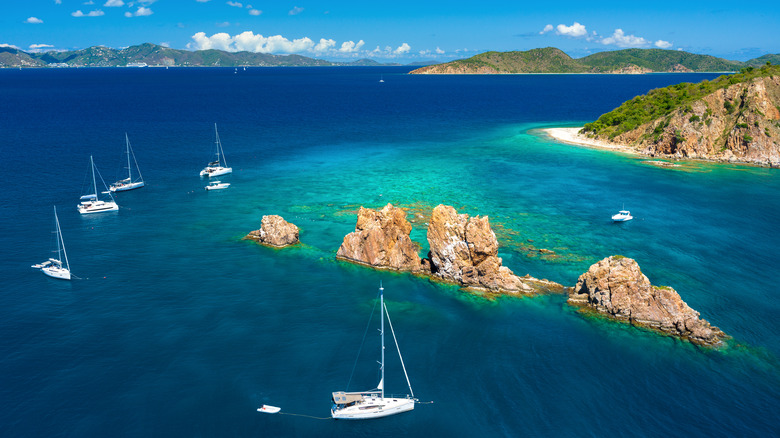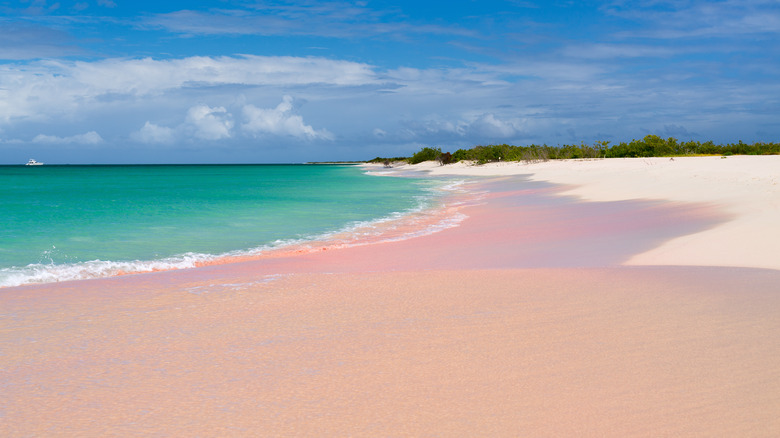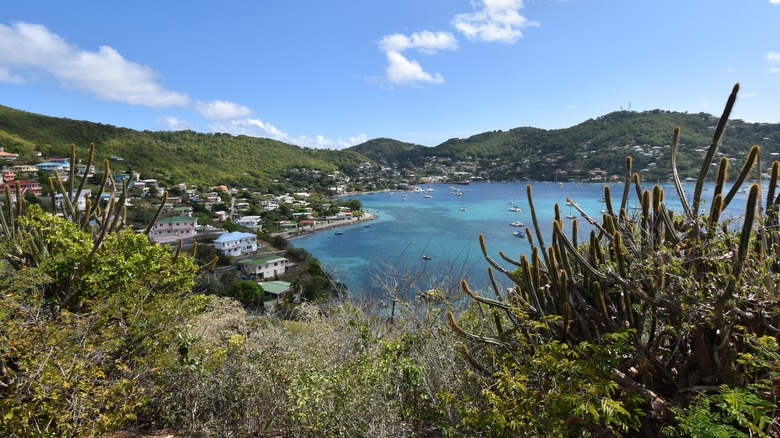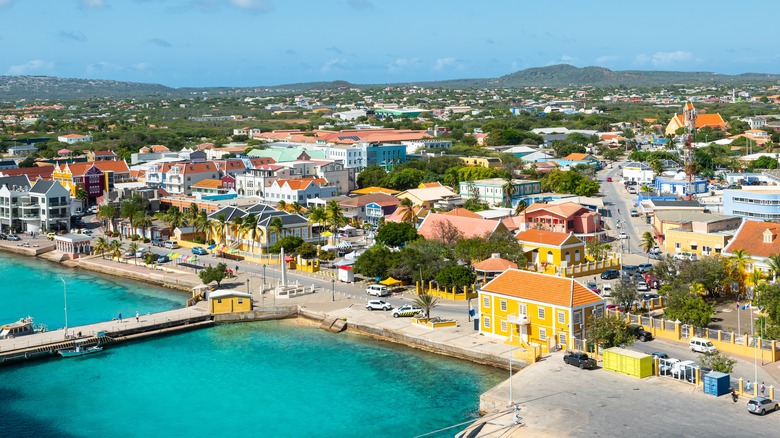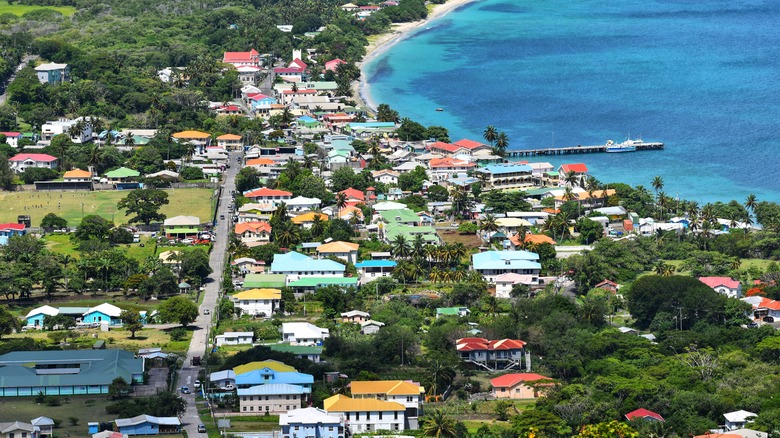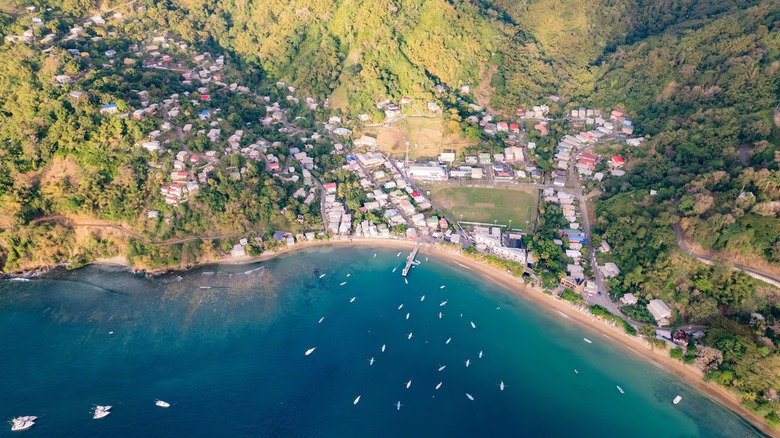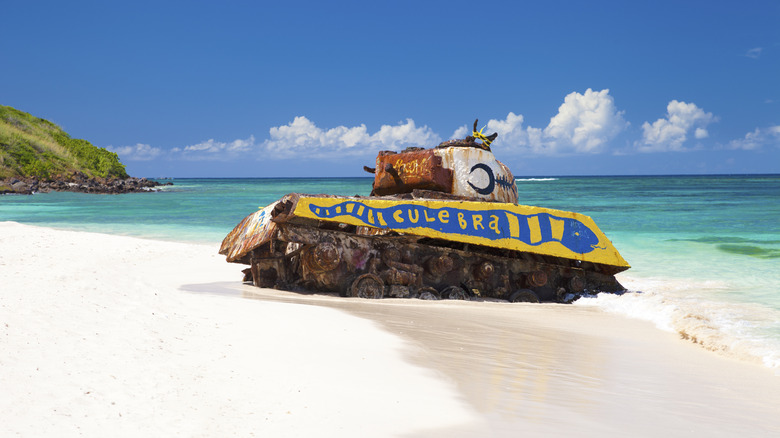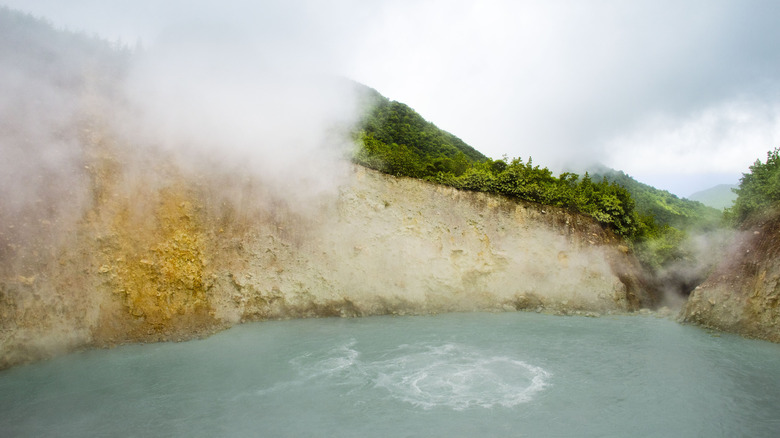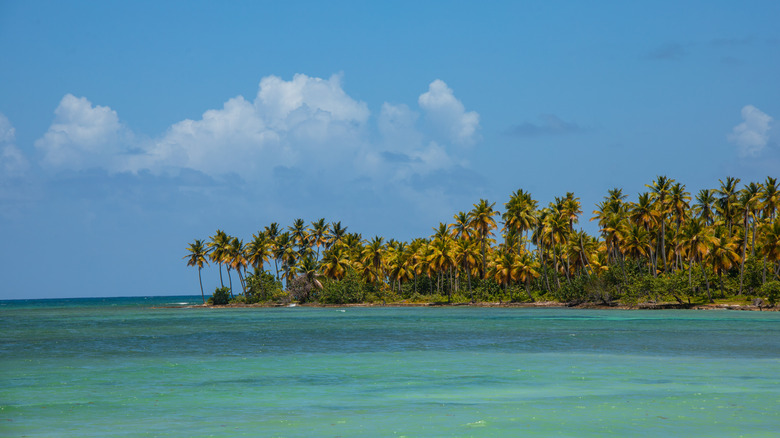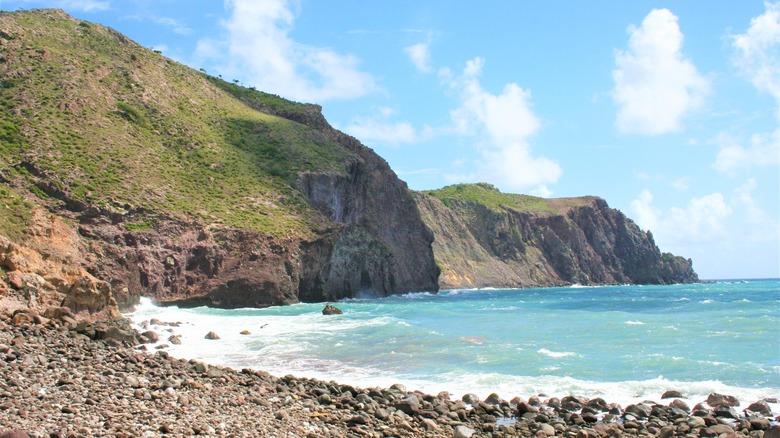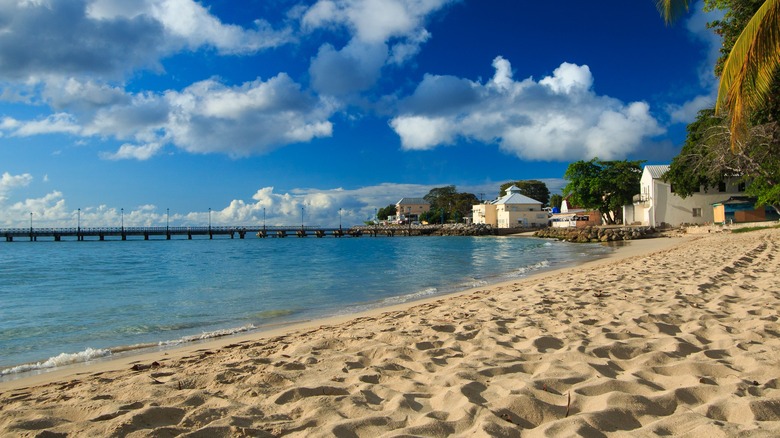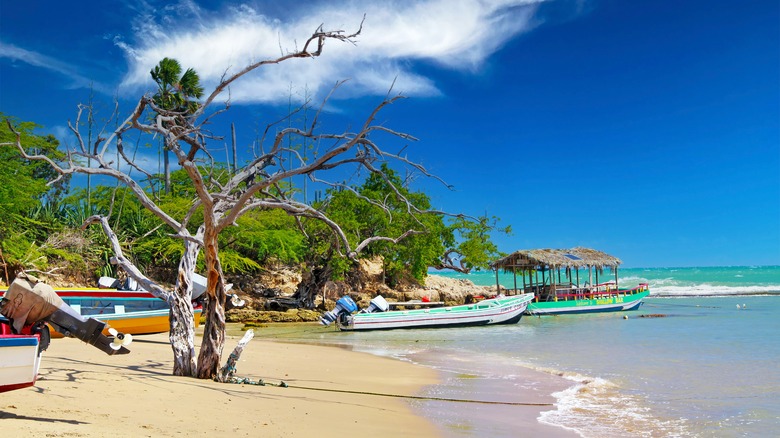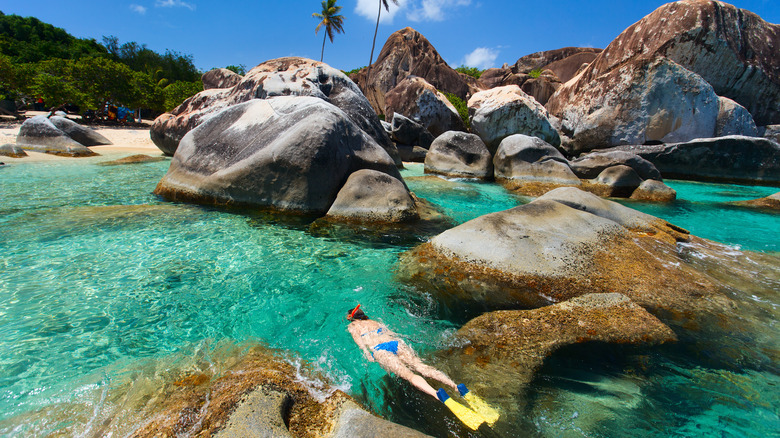Underrated Tourist Destinations To Visit In The Caribbean
A grouping of islands named for the sea where they reside, the Caribbean has long pulled in travelers for its combination of sugar-sand beaches, clear turquoise waters, lazy and slowly rustling palms, and the promise of ceaseless sun. It's a formula that is a runaway success, as the Caribbean welcomed more than 28 million visitors in 2022. That figure includes Caribbean islands, some coastal areas of Mexico, and bits of Central and South America. And yet, despite the obvious appeal and popularity of the entire region, a few choice destinations tend to stick out and pull in the vast majority of visitors.
Everyone knows about Cancún, with its grand range of beaches, and the all-inclusive resorts of Punta Cana in the Dominican Republic. The resort strips of Montego Bay in Jamaica and Grace Bay in Turks & Caicos are hardly the realm of pioneers and will continue to draw droves of vacationers. However, these aren't the only options. For those in search of little-known gems and off-the-radar spots worthy of discovery, the Caribbean holds a trove of choices. And best of all, you won't have to sacrifice the most attractive parts — sun, sea, sand — when visiting under-the-radar Caribbean beaches and islands.
Barbuda
Of the sister islands Antigua and Barbuda, the former seems to get most of the headlines on account of its 365 beaches, one for every day of the year — a fact that has greatly helped in marketing Antigua to beach lovers. While Barbuda might not have anywhere near that bounty of sandy stretches, it does have a dazzling pink-sand beach that is likely to make visitors gasp in awe. Near the main town of Codrington, the sand at Palm Beach is pink because of the crushed shells that blanket its shores. These shells come from minute creatures that reside in the nearby reefs, and when brought to land and endlessly buffeted by the actions of waves and salty water, they break down to generate sand that is speckled with a pinkish hue. As the clear turquoise water meets the rose-tinted shore that gently slopes down into the water, Palm Beach is an undeniably romantic spot, but it's also equally suited to awe families and solo travelers.
Luckily, Barbuda is not a one-hit-wonder, with a good range of other attractions that might surprise visitors to this part of the world. The island has an avian wonder in the Frigate Bird Sanctuary, a refuge for frigate birds. This grand creature with jet-black feathers has a red russet pouch under its beak that it inflates during its mating ritual, a sight that has to be seen to be believed.
Bequia
Regular visitors to the Caribbean need no introduction to St. Vincent and the Grenadines. This scattering of islands is one of the most hypnotic destinations anywhere in the Caribbean, with mesmerizing shades of blue-ringed islands, small and large. For boaties, the island country is akin to the Holy Grail of Caribbean sailing, a never-ending tableau of clear water, hidden coves, deserted beaches, and scenery to make the heart melt. There are 32 islands and cays in total that make up this nation. Covered in blankets of greenery, the islands are often hilly, and some are part of a protected marine park. Nine of the isles support human populations, and of these, perhaps Bequia is the ultimate chilled getaway.
It's a short ferry ride from Kingstown, on the main island of St. Vincent, to Bequia, but its atmosphere feels worlds apart. The island is tiny, with 7 square miles of woods, hills, plains, and cliffs, and home to a population of around 5,000 residents. Life here plays out at a slow, easy-going pace, and pretty soon, you'll find yourself striking up conversations with the people you meet, such is the warm welcome that the islanders offer. Sugar production was a key industry here for years, though today the island is more famous for its annual Easter regatta. But you can visit any time of the year to enjoy showstopper Princess Margaret Beach, named for the late British royal who swam in these waters in 1960 while on her honeymoon.
Bonaire
At the bottom end of the islands, close to the coast of Venezuela, visitors will make out the ABC of the Dutch Caribbean isles — Aruba, Bonaire, and Curacao. Of the three, Bonaire seems to get the least media coverage. Perhaps this is due to its population, which, at about 20,000, is a fraction of Curacao's 152,000, and Bonaire is also significantly smaller than Aruba. The island is not as developed as the other two islands that it usually gets lumped in with, and Bonaire has nothing resembling Palm Beach, which is Aruba's famed resort strip. However, Bonaire certainly promises a much quieter experience than its neighbors, with enviable natural options.
Bonaire features fine wetland areas that serve as popular nesting grounds for turtles and feeding grounds for migratory birds. Bonaire has made a commitment to be carbon neutral in the near future by increasingly adopting sustainable methods of producing energy to protect its fragile environment. For divers, Bonaire is a special place, with diving first kicking off here commercially in the 1960s. The reefs are really vibrant, alive with fish and other sea life, glowing in health and rich in their variety. There are more than 80 dive sites around the island, and 50 of these sites can be easily reached from the shore. With clear waters a given, the visibility is consistently excellent.
Carriacou
A country comprised of three islands, Grenada is a destination blessed with abundant nature, with finely forested interiors and troves of local spices, including fabulous nutmeg. Cocoa also grows here and is showcased in stunning effect by the Grenada Chocolate Company, which makes some of the most delicious, delicately nuanced dark chocolate anywhere in the Western Hemisphere. If you're lucky, you might be able to arrange a tour of the facility. Carriacou, one of Grenada's islands, is a less-known beach destination in the Caribbean, but such anonymity is a boon for travelers who make the effort to come here.
Carriacou, whose name translates to "land surrounded by reefs" (known as Karry-a-cou in the language of the Kalinago Indians), is a beautifully relaxed place, devoid of glitzy resorts, and, as its name suggests, home to some great snorkeling and diving. By ferry, you can reach Carriacou from the main island of Grenada in two hours on average, and in about 20 minutes by plane. It's small enough that exploring isn't hard, as the total area of Carriacou is only 13 square miles. While the laid-back atmosphere is one of the main reasons to visit the hilly island, those in search of some colorful fun and culture can also find it. During the annual Carnival, the pre-Lent festival that is a staple of many Caribbean nations, Carriacou hosts its own unique celebration — Shakespeare Mas — where costumed revelers pretend to fight each other while reciting lines from the bard's play "Julius Caesar."
Charlotteville
A pair of islands that lie in the extreme south of the Caribbean, close to Venezuela, and outside the hurricane belt, the nation of Trinidad and Tobago gave the world calypso, steel pan drums, and the delicious street food of doubles. While Trinidad is where the majority of the country's residents live, Tobago is where to find the most ravishing beaches. At the top end of Tobago, on its west-facing coast, sits the village of Charlotteville, a quiet hamlet set on a curling bay, which is populated by fishermen and a handful of small businesses that cater to intrepid tourists. The scenery here is spectacular, with dense rainforested hills rising up behind the bay, and the calm waters in front of a sandy beach are perfect for a tranquil lounging interlude.
There are plenty of places for a relaxing swim here, including Man O War Bay right in front of the village, and Lovers' Bay a short distance away, where the pink sand offers a romantic contrast to the turquoise shallows. Snorkelers prize Pirates Bay, also close by, where parrotfish frequent the cove's silky waters. The village itself is tiny, with a wee tangle of roads, a handful of places to stay, and a few spots where visitors can eat and drink, but this simplicity is one of Charlotteville's greatest assets.
Culebra
Part of Puerto Rico, but east of its main island, Culebra is a dream destination for nature lovers, with fabulous snorkeling and pristine coastal ecosystems. The beaches here, not surprisingly, are fantastic, with perhaps Flamenco Beach as the most famous string of sand, gleaming white in the sun. The green hills behind the shore accentuate the brilliance of the sand's color even more. The gorgeous turquoise and emerald waters out front are also great selling points. What makes Flamenco Beach even more remarkable are the old tanks on its shores. Covered in rust and graffiti, the tanks are remnants of the U.S. Navy's exercises on the island. It's an eye-catching sight — and also makes for great Instagram posts.
Flamenco, and other beaches nearby, are part of a nature reserve, all but guaranteeing excellent snorkeling at the reefs that sit just offshore. Coupled with mangroves and plenty of seagrasses, the reefs support a thriving marine population of angelfish, stingray, remora, and more. About one-fifth of the island is protected under the Culebra National Wildlife Refuge, and in addition to safeguarding the habitat for nesting turtles, this area is home to thousands of native and migratory birds. For the truly adventurous, a boat ride around some of Culebra's small islands is a joy for the ages, and U.S. citizens don't require a passport to visit Puerto Rico.
Dominica
Not to be confused with the Dominican Republic, Dominica is an English-speaking island, a former British colony, and another slice of natural wonder. While some may visit Dominica for the beaches, there are only a handful on the island. Some beaches feature black sand, while many shorelines are notable for their pebbles and sheer cliffs. The island's interior, however, is a marvel to explore, with jungles, rainforests, and unique geographical features that make the island an adventurer's nirvana. Some of the best hiking anywhere in the Caribbean is in Dominica, from simple treks along the coast or through gorges, to more demanding excursions that require a consistent level of fitness and solid commitment.
One walk that visitors will never forget is the one to Boiling Lake, located in the terrifyingly named Valley of Desolation (sounds like something from "Lord of the Rings"). This body of water, 200 feet across, is considered the world's second-largest boiling lake. Steam constantly rises from it, as the lake is searing hot and perpetually simmering, a hint of the wild geological activity taking place beneath. Passing through terrain that seems both stripped of life, and yet very much alive, it's an immensely rewarding hike, and the sight of the lake will really take your breath away. And after a strenuous walk, enjoy some of the fine local cuisine, prepared with ingredients that grow on the island, or relax in nearby Bubble Beach Spa, a natural hot spring.
Las Galeras
Few islands in the Caribbean have as many all-inclusive resorts as the Dominican Republic, with Punta Cana as a real magnet for this convenient type of hotel model. But even the best all-inclusive resorts in Punta Cana aren't for everyone, as these accommodations are places that guests rarely leave. With virtually everything on-site and much of it rolled into the price of the room, why would they? However, these guests risk being detached from the culture, ambiance, sights, and sounds of the destination itself. For travelers who want to experience a more realistic side of this Spanish-speaking country, Las Galeras, a sleepy village on the Samaná peninsula, is just the ticket.
Sandwiched between two lushly forested promontories, the village is perhaps the antithesis of the commercial tourism found only a few hours' drive away. Come here, and you will only find a few places that offer lodging, similar finite choices for places to eat, and only a few services geared toward tourists (though there is a diving school). However, that is the beauty of Las Galeras. But this doesn't mean it's a boring destination; quite the contrary. For starters, beaches like Playa Rincón and Playa Madama are truly world-class, with soft sand and silky seas. There are also great opportunities for hiking, mountain biking, ATV jungle excursions, surfing, and astounding diving.
Montserrat
Fans of the timeless, reggae-influenced British band The Police might have heard of Montserrat. This mountainous island is a British Overseas Territory, and in 1981, The Police retired to the island's Air Studios to record arguably its finest album, "Ghost In The Machine," which featured the politically charged "Invisible Sun" and the mystical, sweeping "Secret Journey." Montserrat has also been in the news for its volcanic eruptions, some of which have been devastating, and yet its undulating topography is a large part of its charm.
The island is wild and rugged, with peaks rising into the clouds, as rocky promontories topped by trees push out into the sea. The upshot of this is that the hiking on Montserrat is fantastic and will appeal to walkers of all abilities. Some walks can last less than an hour, like the Underwood hike that connects other trails and weaves through agricultural pastures and sections of deep forest. For a more testing option, the five-hour Hope Ridge Trail, which can be broken up into sections (so the walk can be shorter), enters cloud forest, which is a cooling, thrilling treat and offers inspiring views across the island and sea.
Speightstown
In the north of Barbados, Speightstown is a town rich in history and the second-largest spot on the island after Bridgetown, the country's capital. Speightstown dates back more than 350 years, named for a rich businessman who commanded large parcels of land here centuries ago. It started as a busy port, linking trade in the Caribbean with the West England town of Bristol, and at one time, the Barbadian town was known as Little Bristol. Over time, fortifications were also built to safeguard the port and protect the island from invaders. Although there aren't remnants of these structures, Speightstown still boasts plenty of historic buildings.
Arlington House was built in 1750, a former private home, and showcases the type of architectural style that later found its way to Charleston, South Carolina, when Barbadians moved there to set up plantations. Today, Arlington House is a museum that traces the town's history. It also features a sailing simulator and a Stede Bonnet exhibit. (Bonnet was known as the Gentleman Pirate whose exploits were used to comic effect in the TV show "Our Flag Means Death"). Elsewhere, visitors can visit St. Peter's Parish Church, a historic Georgian-style church, explore lively fruit and vegetable markets, sample local rum, and try the national dish,cou-cou with flying fish (a fish stew served with polenta).
Treasure Beach
Visitors to Jamaica often head to the resorts of Montego Bay. Set alongside a scintillating sea in the country's northwest, Montego Bay is served by its own international airport. But Montego Bay, with its series of waterfront properties and the tourist-thronged, overtly commercial "Hip Strip," doesn't accurately reflect the true beauty of Jamaica, its natural bounty, or the warmth of its welcoming people. However, one place that does showcase this side of the country is Treasure Beach. A quiet area on the south of the island, Treasure Beach might not have the sugar-sand beaches and turquoise waters of Montego Bay, but it does offer a more intimate, authentic Jamaican journey.
Visitors here will encounter small bays and hidden coves, coastlines that alternate between sand and rocks, and a low-key vibe that helps days blissfully stretch out, allowing travelers to really decompress. Fishing is still important here, and colorful boats line Calabash Bay each day as fishermen sell their daily catch. For lovers of fresh fish, this place is paradise, though other specialties like curried goat and jerk meat are also menu staples.
Virgin Gorda
Certain beaches are beautiful in their own right, with no hidden appeal than the obvious, while others seem to possess a special layer — a quality that makes them almost cinematic in their splendor. In the latter category, you can think of Anse Source d'Argent in the Seychelles or Sarakiniko Beach on the Greek island of Milos. To that list, you should also add The Baths National Park on the southwestern tip of Virgin Gorda of the British Virgin Islands. Here, a scattering of mammoth granite boulders, some more than 30 feet across, make the turquoise seas and white sand seem even more stunning. Sometimes rock pools form in between the boulders, which fill with sea life waiting to be explored. You can also explore the waters beyond the beach, which are great for leisurely swims and languid snorkel jaunts.
Virgin Gorda is the third largest of the British Virgin Islands, and it owes its name to Christopher Columbus, who imagined the island's contours as a woman in repose. Visitors will find plenty more to see on Virgin Gorda than a bunch of big rocks. You can crisscross the terrain hiking through nature refuges, or explore historic settlement sites of African, Indian, and Spanish populations who once lived here.
